While we have not had the opportunity to field-test the framework for structured thinking about policy delivery systems developed in the paper, we have reached back into some of our previous experience to provide some partial examples of how we might have applied it had we had the framework at the time. This exercise was particularly useful because in rethinking our own experiences we were able to identify gaps in the framework: to some extent, therefore, its development has already been strongly inductive. We must caution that the examples are incomplete since memory is imperfect and there are information gaps as the focus of our analysis at the time was not the policy delivery system.
Example 1. Agricultural Statistics Collection in the Republic of Korea (K1.eg)
The South Korean Ministry of Agriculture and Fisheries (MAF) is responsible for collection of agricultural area, yield and production statistics, including crop estimates. The policy of MAF was to produce these statistics on a timely basis and as accurately as possible. To that end, MAF had ample field enumerators who were well trained in sampling techniques and statistical enumeration. It was evident that the MAF enumerators were doing a conscientious, excellent job.
Yet when the production figures were adjusted to account for exports, imports, seed and post-harvest losses, converted to calories and divided by population, the only conclusion that could be drawn was that every Korean should weigh about 400 pounds (182 kg). When the adjusted production figures were compared with household consumption survey data, which were believed to be quite accurate, a systematic upward bias was found in the production time series data ranging between 12 percent and 20 percent for the cereals, rice, barley and wheat.
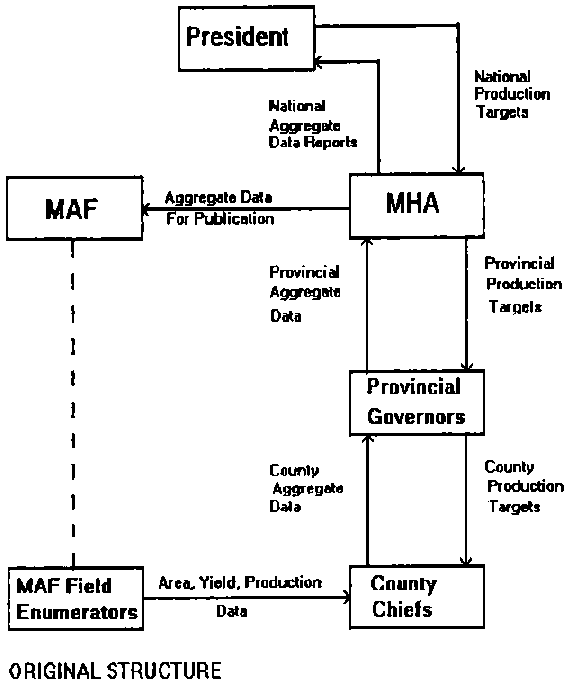
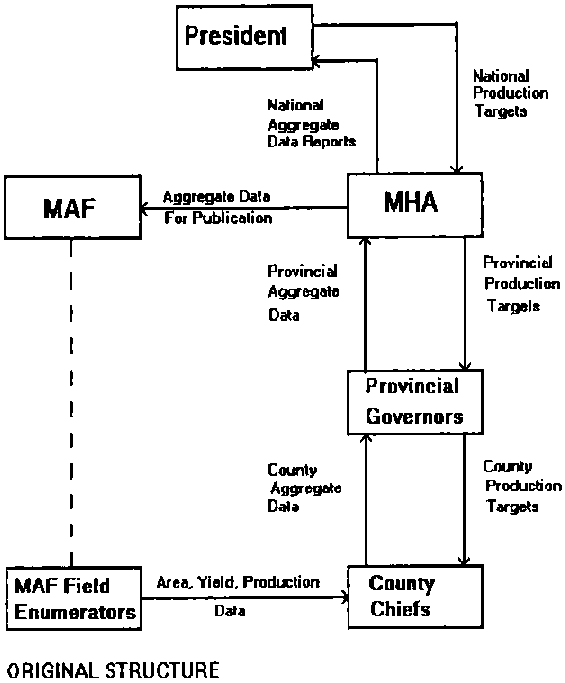
The structure of the policy delivery system was the cause. The MAF field enumerators turned over their results to the county (Gun) administration for aggregation and passing on to the province level where they were aggregated again and sent to Seoul for final aggregation at the national level. The offices responsible for aggregation of the data at county, province and national levels were under the Ministry of Home Affairs (MHA); the results were ultimately passed back to MAF for publication. Provincial governors were appointed by the President and in turn appointed the county chiefs, all under the administration of MHA. Production targets by crop flowed down from Seoul through the provincial governors to the county chiefs, and the results from the MAF field enumerators flowed up through the same channels. The conduct was that since neither the county chiefs nor the provincial governors were going to report themselves as failures, the production always met or exceeded targets. The result, the performance, was that the production statistics were systematically biased upwards.
The structure of the delivery system was changed in the late 1970s by cutting MHA out of the channel and making MAF responsible for the data aggregations all the way from the field enumerators to the national level. This, of course, created a break in the statistics that was going to be a political problem for the Minister unless explained away. The solution was to announce that a new conceptual base and methodology was being introduced into the MAF statistical collection activity that would result in lower production figures. Historical data were adjusted to take out the systematic bias and to create a consistent historical time series.
In retrospect, the conduct of the parties involved and the resulting performance could have been anticipated, given the structure of the statistical collection system. In our framework, the failure to achieve effective performance arose because of de facto unenforceability: the informal rules were such that the political and agricultural statistics functions were not separable in that structure. There might still be sources of systematic bias in the system, but at least an important and obvious one was removed. These authors will never know the content of the discussions that had to have taken place within the President's cabinet that resulted in the decision to allow the MAP statistics bureau chief to implement the change in the system. Presumably, since Korea was approximately self-sufficient in rice, the most political of the grains, by the mid-1970s when the change took place targets were no longer important.
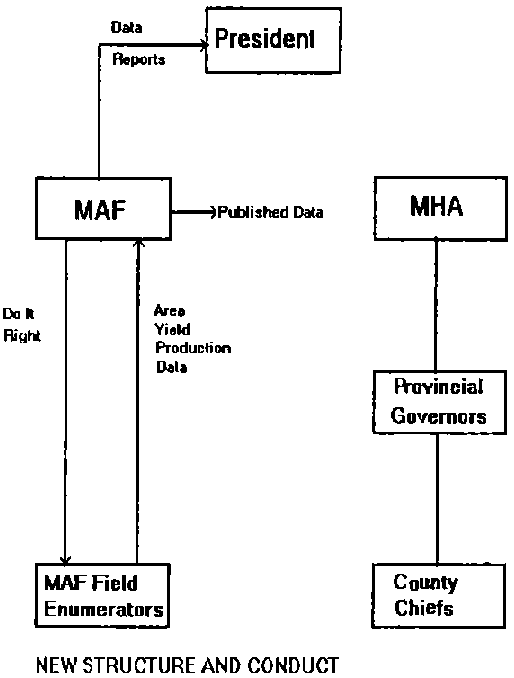
Example 2. Agricultural Input Supply in the Republic of Korea (K2.eg)
In the 1970s, the South Korean National Agricultural Cooperative Federation (NACF), a parastatal farmer cooperative operating under the auspices of the Ministry of Agriculture and Fisheries (MAF) was responsible for, inter alia, delivery of fertilizer, chemicals and seed to Korean farmers. It became evident that a "grey market" was operating, particularly in fertilizer, in the countryside, with some farmers purchasing more fertilizer than their needs from NACF and reselling to neighbouring farmers. Outward appearances could not explain the presence of the grey market, since all farmers were members of the local cooperative and should have had equal access.

Further, NACF had a network of "extension" workers operating at local level, purportedly providing advice and technical information to farmers. This seemed curious since MAF operated a national extension service with local offices that appeared to be quite good, reliable, and much used by local farmers. NACF, unlike farmer cooperatives as we know them in the western world, was controlled by the government with government-appointed officers throughout. Further investigation revealed that NACF, through the network of "extension" workers, was the ruling party's ward system in rural
Korea. The "extension" workers were there to make sure that the Korean farmers thought and voted "correctly". If they did not, the sanction by the "extension" worker was to withhold inputs, mainly fertilizer. Hence the fertilizer grey market.
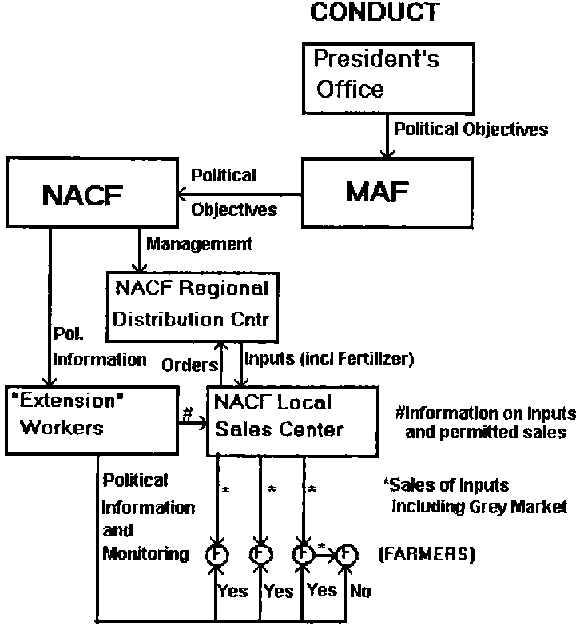
The policy was to make modem inputs available to farmers and to use NACF to do so. The structure was a cooperative system controlled by MAF that indeed worked well in making inputs available in plentiful quantities and at reasonable cost through the local cooperative outlets. But control of the cooperative system by MAF allowed control through the Ministry by the President's office for political purposes. The conduct was to use the NACF for political purposes by withholding fertilizer from farmers who were not politically correct. The performance was that inputs were not distributed in an equitable way to all farmers, which resulted in a grey market. The system was effective, efficient and enforceable for political purposes; it was neither effective nor equitable for agricultural production purposes.
In the early 1990s, farmers were allowed to elect their national and local cooperative leaders. To what extent this has broken the hold of the ruling party on the organization is not known to these authors, but we expect that it is at least weakened.
Example 3. Marketing of Export Crops in Sierra Leone15 (SL.eg)
(15 This example is based on the work of one of the authors, published in MAFF/FAO 1992.)
The Sierra Leone Produce Marketing Board (SLPMB) was established after WWII with the intention of securing the most favourable arrangements for the producers of export crops, and was made the monopsony purchaser (through its buying agents) and monopoly exporter of cocoa, coffee, palm kernel, and other export crops. During the first half of the 1980s, its purchases of cocoa, coffee and oil palm were quite buoyant, but they declined rapidly from the mid-1980s. The peak of SLPMB's cocoa and coffee purchases was reached in 1984/85 (11 000 tonnes and 10 000 tonnes, respectively). By 1988/89, these figures had dropped to 5 000 tonnes and under 3 000 tonnes, with no reduction in the area under cultivation. In other words, even if productivity had fallen, that could not explain the fall in purchases. In 1991, SLPMB's monopsony powers were taken away (although it still then retained the export monopoly), and the domestic market was opened up to private traders. At the same time, the government introduced a minimum producer price of 60 percent of f.o.b. world market price. Official coffee and cocoa exports leapt up to a total of 23 000 tonnes in 1990/91, with SLPMB purchasing 36 percent of domestic production.

Over the years, SLPMB had expanded its range of activities into oil palm plantation ownership and palm kernel processing (and other upstream processing), and had in 1979 been landed with the responsibility for taking over the operations of the Rice Corporation in both domestic purchases and rice importation. This led to financial and management problems, exacerbated by politicization of the institution and diversion of funds for Treasury and private gain. Serving the interests of export-crop producers ceased to figure high on its agenda.
In consequence, SLPMB lost its effective monopsony in the mid-1980s. Export crops were being taxed at a rate of about 30 percent, and the average producer price paid by SLPMB was less than 50 percent of f.o.b. world market price. Although the Leone underwent a series of massive devaluations that should have increased the incentives to producers of export commodities, inflation was running at very high levels and the Leone was not convertible. Further, while the world prices of coffee and cocoa have been falling over time in real terms, they have fluctuated substantially in the short run in nominal terms. Sierra Leonean producers had an alternative to SLPMB and the vagaries of their own macroeconomy in their historic cross-border trading links with Liberia, whose currency was tied to the US dollar. The loss of this market opportunity because of the Liberian civil war and consequent currency turmoil coincided with the liberalization of domestic marketing in Sierra Leone. The competitors to SLPMB offered a better service to farmers through price premiums and a pre-financing system, and a barter system to provide essential consumer goods (including rice, which, in Sierra Leone, acts as an inflation-proof form of cash) in exchange for produce.
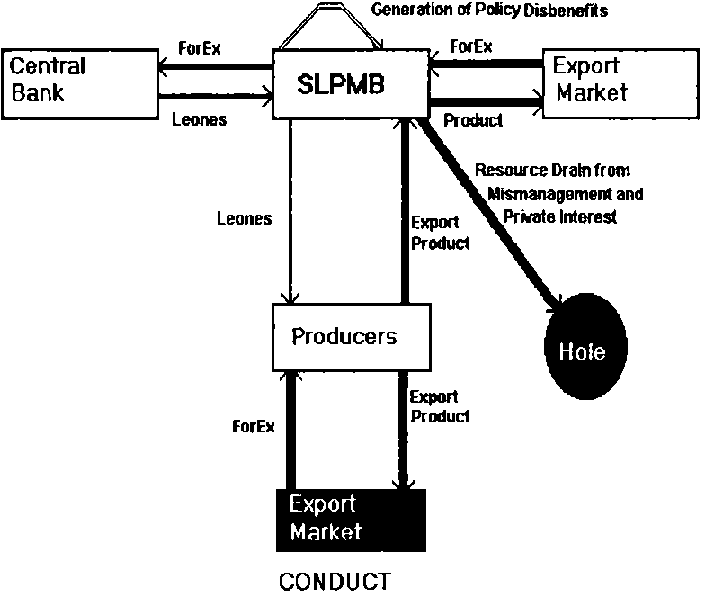
This example is particularly interesting because the main institutional player in the policy delivery system, SLPMB, was also supposed to be the generator of the policy benefits. Through its buying and selling operations, it was supposed to be able to use its monopsonistic and monopolistic powers to benefit the small-scale producers (and all coffee and cocoa production in Sierra Leone is in the hands of small-scale producers - there was never any plantation production of those crops) by reducing their marketing costs and negotiating a better international price for their exports. As indicated, the structure consisted of SLPMB with monopsony/monopoly powers in the export crop market, and no farmer control of the organization's operations. Conduct shows a combination of circumstances: acquisition of extraneous enterprises, mismanagement, diversion of funds to private interests, a volatile domestic macroeco-nomy and a ready hard currency market in neighbouring countries (not all of which are depicted in the flow chart) allowed producers to develop a lucrative cross-border black market. This further depressed the price offered to producers and exacerbated the decline of SLPMB to the point that in terms of performance its effectiveness in accomplishing the original policy objective could only be judged as dismal. The mismanagement and appropriation of funds for private gain destroyed its operational efficiency. The rules against the black market were unenforceable since the alternative hard currency market and higher prices across the border was irresistible, i.e., the system was unenforceable in principle because of mass disobedience with respect to the formal rules. Any serious attempt at enforcement would have been extremely costly because of the lengthy land border and difficult terrain, and the benefits of enforcement would not have accrued to those bearing the costs. In other words, far from generating policy benefits, SLPMB successfully generated policy disbenefits.
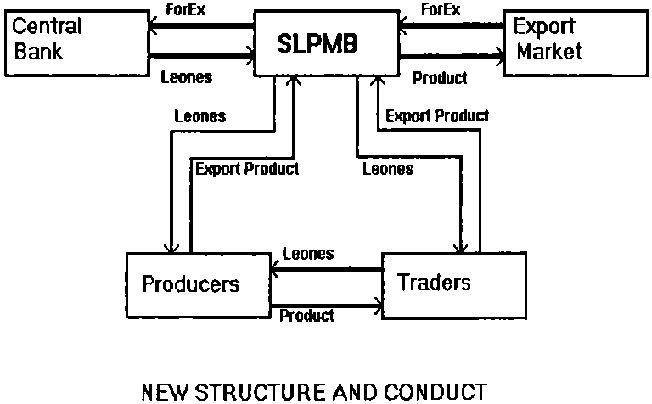
The solution in this case was to abandon the policy, open the domestic market to private traders and establish a minimum producer price of 60 percent of the f.o.b. export price, enforceable through SLPMB. This, coupled with the war across the border, eliminated the black market and reinstated SLPMB as the monopoly exporter of Sierra Leone export production.
With regard to equity, under the original structure all producers were treated equally badly.